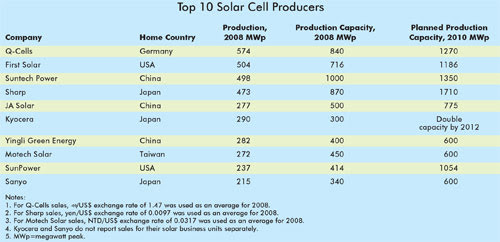Germany, Germany, Germany. It seems as if all anyone talks about in terms of the hottest place for solar is Germany. But others are turning up the heat, creating hot spots in Asia and the US as well.
According to the “Europe’s Solar Market: Is the Outlook Still Sunny?” report released in May by London-based Frost & Sullivan, it takes research, manufacturing and government support to make a well-rounded industry. And, according to Alina Bakhareva, program manager of renewable energies at Frost & Sullivan and author of the report, much is happening around the world in each of these areas.

Only one German solar manufacturer is listed in the top 10 globally, while Asian solar manufacturers are proliferating. All plan to expand production rapidly in the next year. Source: Frost & Sullivan.
Research
Lowering the cost and increasing the performance of solar cells are keeping researchers everywhere busy as they look for new sources of energy. There is an increasing focus on reducing cost and improving efficiency for cells and modules as well as on making manufacturing methods more efficient. Although the report focuses primarily on the European solar industry and lists Germany, the Netherlands, France, Italy and Switzerland as leaders in solar research, Bakhareva said she would add China and the US to a list of global research leaders.
Manufacturing
It used to be that solar cells and modules came from European and Japanese manufacturers, but now, Chinese and Taiwanese cell producers have achieved a market share of more than 40 percent, moving them into the top 10 spot. What sets many European manufacturers apart is that they have been at it long enough to be virtually fully integrated. They own – or have – long-term supplier/buyer agreements for everything from raw materials through finished solar systems.
Another trend is that well-established European and US players, such as Q-Cells SE of Bitterfeld-Wolfen, Germany, and REC Solar of San Luis Obispo, Calif., are setting up shop in Asia, and with good reason: Governments are offering incentives such as tax holidays and low-interest loans.
Government support
Government support dating back to the early 1990s got Germany to the top of the solar charts, and recent US support for renewables is pushing the US solar industry up the list as well. Government support absolutely correlates to installed projects, according to Bakhareva, who noted that, “Whenever we see new support programs introduced, we see a surge in the market. In 2008, we saw the market in Spain surge as it installed more systems than any other country, and we are seeing the same trend in Italy and Greece, despite administrative hurdles.”
One Asian government luring manufacturers with tax holidays and loans is Malaysia. Bakhareva said she is amazed at the number of plants being erected there. Q-Cells, for instance, is constructing a solar cell manufacturing facility and plans to have an overall capacity of 300 MW by the end of this year. India also is granting tax holidays and low-interest loans.
Government support also extends to the end user, which could be the business or homeowner who invests in solar. Programs of this type include feed tariffs, grants and accelerated depreciation.
Changes ahead
Because the global economy remains shaky, solar likely will see a dip in residential and retail installations. Large-scale projects, however, will move ahead, the report contends, with institutional investors showing interest in the solar photovoltaics market.
The greatest change that has taken place is the globalization of the market. Economies of scale now are coming into play, and low-cost manufacturing in Asian countries is closer to becoming a reality. The potential for both consolidation and production outsourcing seems likely for the future; however, about 50 percent of the market currently is controlled by just 10 cell manufacturers.
Solar in India
The government of India recently announced its National Solar Mission, which calls for 20 GW installed by 2020, 100 GW by 2030 and 200 GW by 2050. This in a country that currently has only 3 MW of solar capacity in place.
Ramping up will require government funding – $18 million to $22 million has been set aside for the project – and a carefully executed plan that calls for implementation in three phases.
The first phase, deployment, will take place through 2012, with the goal of installing 100 MW by promoting utility-scale projects and mandated rooftop installations on government and public buildings.
The second phase, which will be completed by 2017, will promote solar thermal power plants, and the third will culminate in 2020, by which time the government hopes to have achieved grid parity and to have solar systems installed on 1 million rooftops.
Ramping up solar in India is one way to bring dependable electricity and lighting to areas that have gone without or that have suffered with intermittent power.